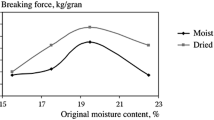Conclusions
The intensive formation of the pellets (granules) of caustic magnesite dust commences from the moment of completion of the decarbonization of the particles of raw magnesite. The development of pellets is established at a distance of 29 m from the charging end of the kiln.
The formation of grains and their densification and reinforcement occur in the section 29–45 m of the length of the kiln as a result of the compaction of the particles of caustic dust.
The recrystallization of the periclase, sintering, and agglomeration of the powder occur mainly in the section 45–75 m of the furnace length in the presence of melt.
During the burning in a 90-m rotary kiln of unground caustic magnesite dust, the apparent porosity of the powder resulting from its grains diminishes from 50–60 to 24%.
Similar content being viewed by others
Literature cited
N. F. Bugaev et al., Ogneupory, No. 2, 5 (1967).
V. V. Timashev et al., Trudy D. I. Mendeleev MKhTI No. LV, 204 (1967).
Author information
Authors and Affiliations
Additional information
Translated from Ogneupory, No. 8, pp. 52–55, August, 1971.




